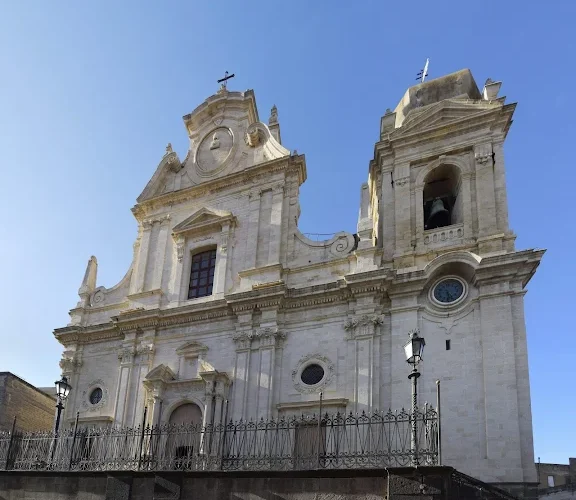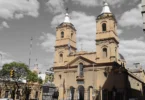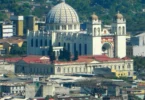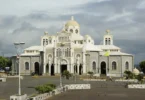Introduction
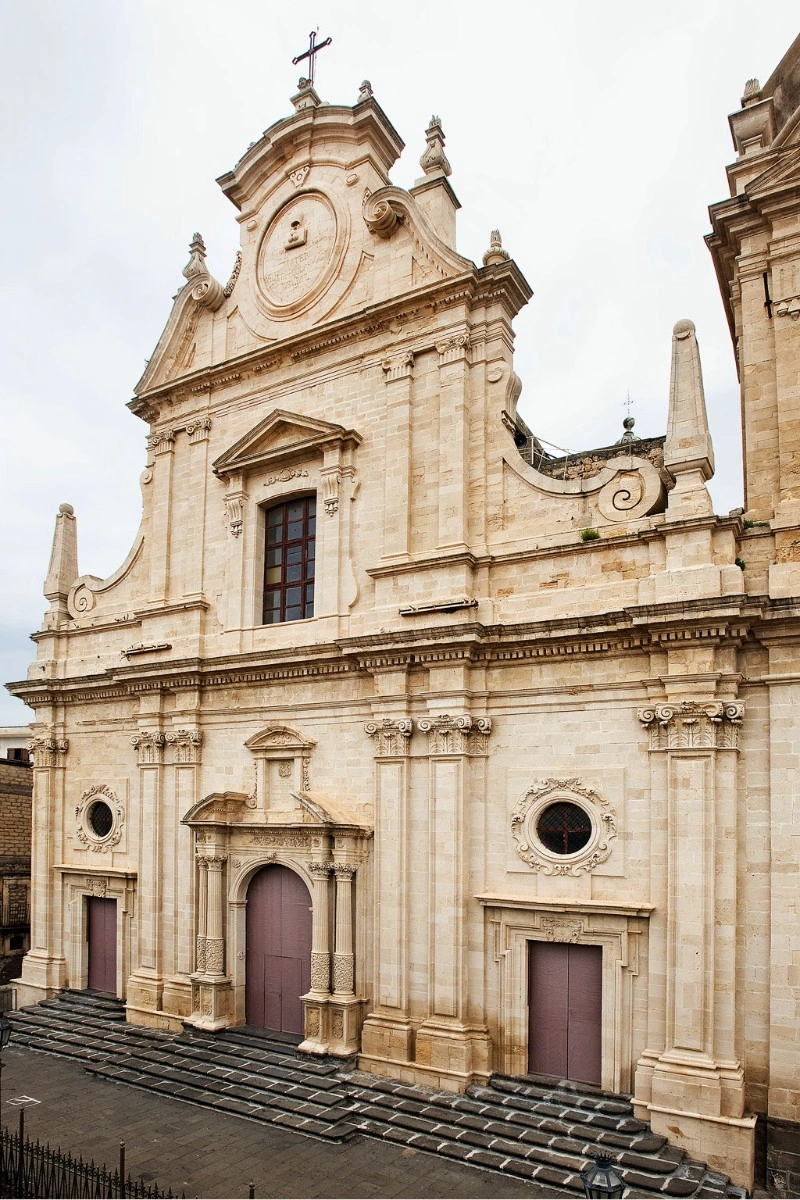
The Mother Church of San Nicolò and the Santissimo Salvatore is a prominent religious and historical landmark located in the heart of Militello in Val di Catania, a charming town in the province of Catania, Sicily. This magnificent church serves as the town’s principal place of worship and plays a central role in the spiritual and cultural life of the local community. Dedicated to Saint Nicholas and the Most Holy Savior, the church reflects the deep-rooted Catholic tradition of the region and stands as a testament to centuries of devotion, artistic heritage, and architectural grandeur. Positioned within the town’s historic center, the church not only dominates the surrounding skyline but also attracts visitors with its blend of baroque artistry, historical significance, and sacred atmosphere.
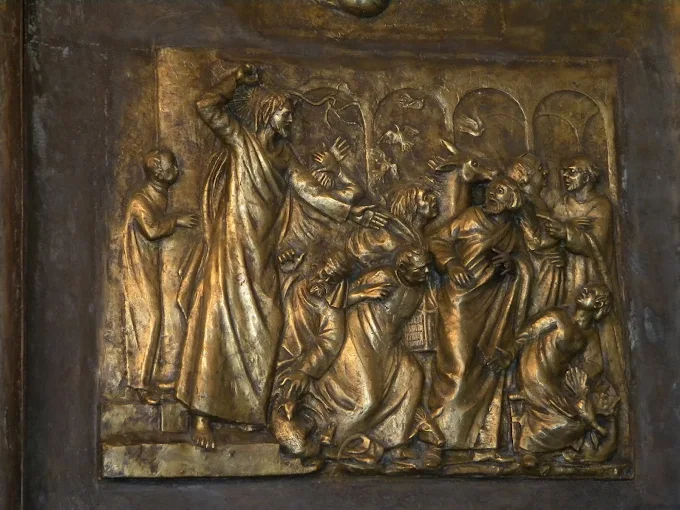
Aragonese–Spanish Era: Origins and Early Significance
The original mother church of Militello in Val di Catania, known as San Nicolò il Vecchio, served as the town’s main place of worship and spiritual center. Its construction was promoted by the influential Barresi–Branciforte noble families, who played a significant role in the religious and cultural development of the city during the Aragonese-Spanish period. The structure stood as a symbol of civic and ecclesiastical authority. However, the church suffered considerable damage during a prolonged seismic swarm referred to in historical sources as the Magnus Terremotus in terra Xiclis. Over the years, the monument underwent various phases of repair, expansion, and enhancement. Despite these efforts, the catastrophic 1693 Val di Noto earthquake led to the total destruction of the original complex. From the 18th century onwards, the ruins of San Nicolò il Vecchio were gradually stripped of materials, furnishings, and artworks, many of which were repurposed in the creation of the new Matrice church.
Bourbon Era: Reconstruction and Architectural Renewal
In the aftermath of the 1693 disaster, religious services were temporarily held in the Church of the Madonna della Catena, followed later by the Church of San Sebastiano. On December 6, 1721, exactly 28 years after the devastating earthquake, the first stone of the new mother church was ceremonially laid. Construction of the new building, intended to replace the ancient matrix, began with a design that emphasized both grandeur and verticality. The church opened for worship in 1740. The first order of the Baroque façade, designed by architect Girolamo Palazzotto, was completed in 1750. Later, in 1765, renowned architect Francesco Battaglia of Catania oversaw the construction of the second order and the bell tower, which features a distinctive oriental-style dome.
Contemporary Era: Modern Enhancements and Global Recognition
Significant additions and modifications were made during the late 19th and early 20th centuries. The church was expanded to include a transept and apse, enhancing its liturgical function and spatial configuration. In 1904, a remarkable 30-meter-high dome was constructed atop a tall drum with large windows—one of the first examples of reinforced concrete architecture in eastern Sicily. Notably, the design model of this dome earned first prize at the 1900 International Exhibition in Paris, showcasing its architectural innovation. Following the Santa Lucia earthquake on December 13, 1990, the structure underwent major restoration and structural consolidation to ensure its preservation. On June 28, 2002, the church was officially listed by UNESCO as part of the Val di Noto World Heritage Site, in recognition of its cultural and historical value. Most recently, in 2022, the church received the prestigious title of Pontifical Minor Basilica, further affirming its importance in the ecclesiastical and artistic heritage of Sicily.
Architecture of Mother Church of St. Nicholas and the Most Holy Savior, Militello in Val di Catania, Italy

Facade
The church’s late Baroque facade is both elegant and monumental, characterized by eight large pilasters with high bases and Corinthian capitals. At its center, the main portal—originally part of the main altar from the former mother church—stands prominently. It features twin columns and a broken arch tympanum, creating a visually striking entrance. Flanking the central doorway are two side entrances, poetically named the “Door of the Sun” and the “Door of the Moon”, each surmounted by rose windows that provide both light and symbolic significance.
Interior
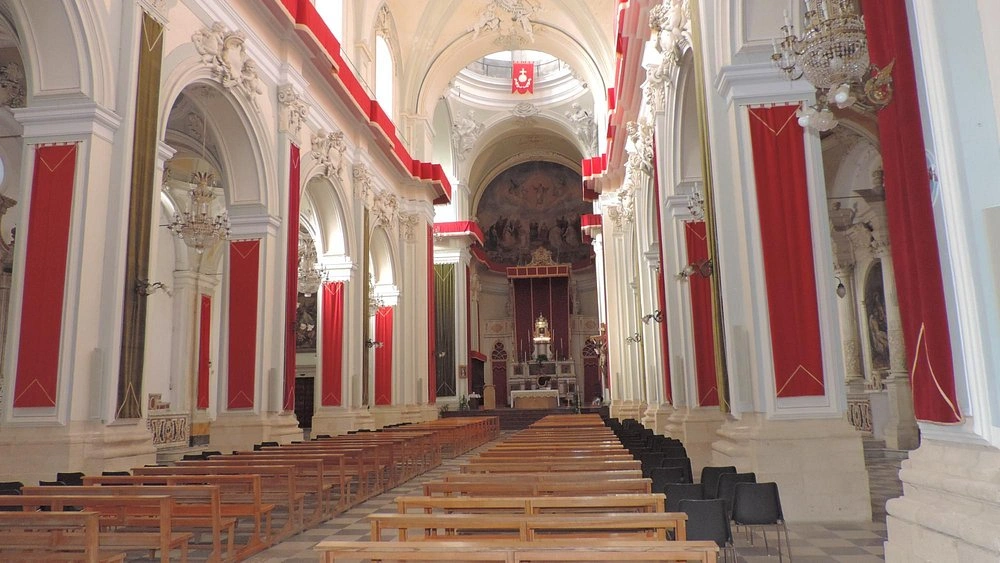
The interior follows a Latin cross layout, consisting of three naves divided by five arches supported by twelve pillars. These pillars are adorned with Ionic capitals and enriched with refined 18th-century stuccoes. In the pendentives of the dome, visitors can admire statues of the Four Evangelists, sculpted by Giuseppe D’Arrigo, a prominent artist from Catania. In 1950, local painter Giuseppe Barone decorated the vault and apse with frescoes depicting scenes from the life of Saint Nicholas and the Glorious Mysteries of Christ, including The Three Gifts of Saint Nicholas, The Story of Saint Nicholas, and The Apotheosis of the Most Holy Savior.
Left Aisle Chapels
The left aisle of the Mother Church of San Nicolò and the Santissimo Salvatore is equally rich in religious and artistic significance, beginning with the Baptistery, a serene space enclosed by a wrought iron gate. At its center stands a Carrara marble baptismal font surmounted by a bulbous wooden dome, symbolizing spiritual rebirth. Adjacent to it is the Chapel of the Holy Family, originally dedicated to the Madonna delle Grazie, which now houses a beautifully crafted 1748 Neapolitan sculptural group of the Holy Family, nestled within an elegant niche. The Chapel of the Sacred Heart of Jesus follows, distinguished by its polychrome marble altar and a wooden statue of the Sacred Heart created by the noted Sicilian sculptor Girolamo Bagnasco, whose works are renowned throughout the region. Next is the Chapel of Saint Lucy, which preserves a 17th-century statue of the virgin and martyr, accompanied by a refined polychrome altar—both original elements from the town’s former mother church, San Nicolò il Vecchio. The final chapel in this aisle, the Chapel of the Holy Crucifix, was repurposed in 1992 as a votive chapel. It is centered around a poignant 17th-century Crucifix attributed to an unknown artist, flanked by candle-bearing angels in the Roman style, creating a space of contemplation and solemn devotion. Collectively, these chapels offer a journey through faith, art, and historical memory, enriching the spiritual and cultural atmosphere of the basilica.
Right Aisle Chapels
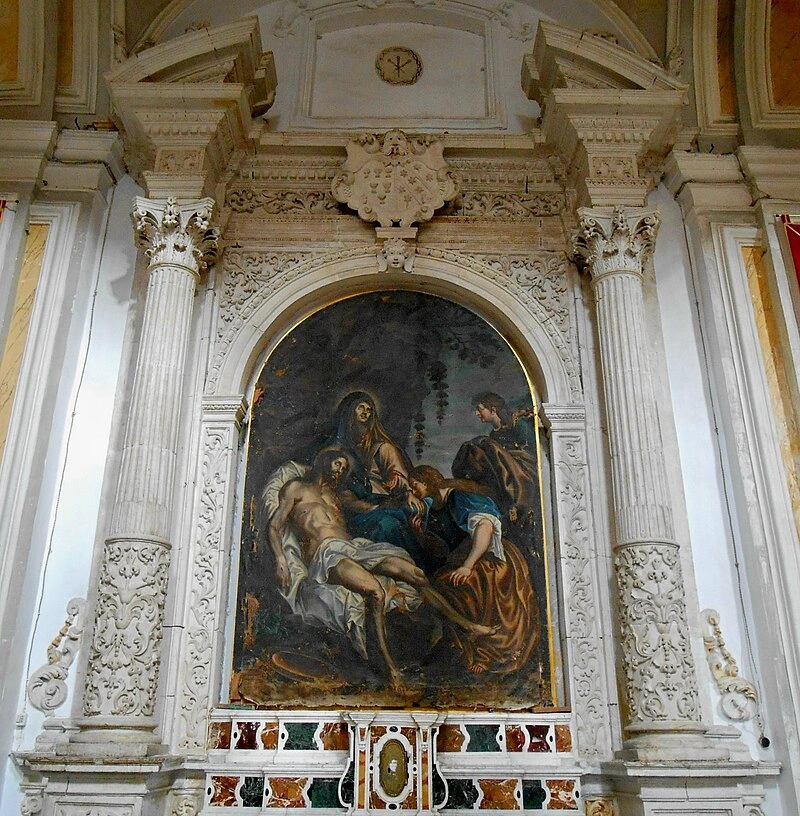
The right aisle of the Mother Church of San Nicolò and the Santissimo Salvatore features five chapels, each reflecting layers of devotion, history, and artistic craftsmanship. The first is the Chapel of San Gerardo Maiella, originally dedicated to Saint Andrew, now home to a papier-mâché statue of the Redemptorist saint. Surrounding it, a series of frescoes painted in 1921 by Giuseppe Barone depict the Miracle, Ascension, Communion, and Death of San Gerardo, capturing key moments of his spiritual journey. The second chapel, once devoted to Saint Eligius, now honors Saint Anthony of Padua with a finely carved 17th-century wooden statue, while the original statue of Eligius is preserved in the church’s museum. The third chapel, initially dedicated to Saint Nicholas of Bari, was re-consecrated in 1906 to the Madonna del Carmelo, expressing the deep Marian devotion of the local faithful. The fourth chapel, once the Chapel of Our Lady of Sorrows, showcases a striking 17th-century marble architectural setting with Corinthian columns, decorative arabesques, and a broken arch tympanum. Originally housing a wooden Pietà group, now kept in the museum, the chapel has enshrined a statue of Saint Rita of Cascia since the 1950s. The fifth and final chapel in the aisle, previously dedicated to Saint Francis de Sales, now venerates Our Lady of Pompeii. It features a papier-mâché ensemble from the Lecce school, depicting the Virgin of the Rosary flanked by Saint Dominic and Saint Catherine of Alexandria, framed by panels representing the fifteen Mysteries of the Rosary. Each of these chapels not only enriches the spiritual landscape of the church but also preserves the artistic and devotional legacy of Militello across centuries.
Museum of Sacred Art
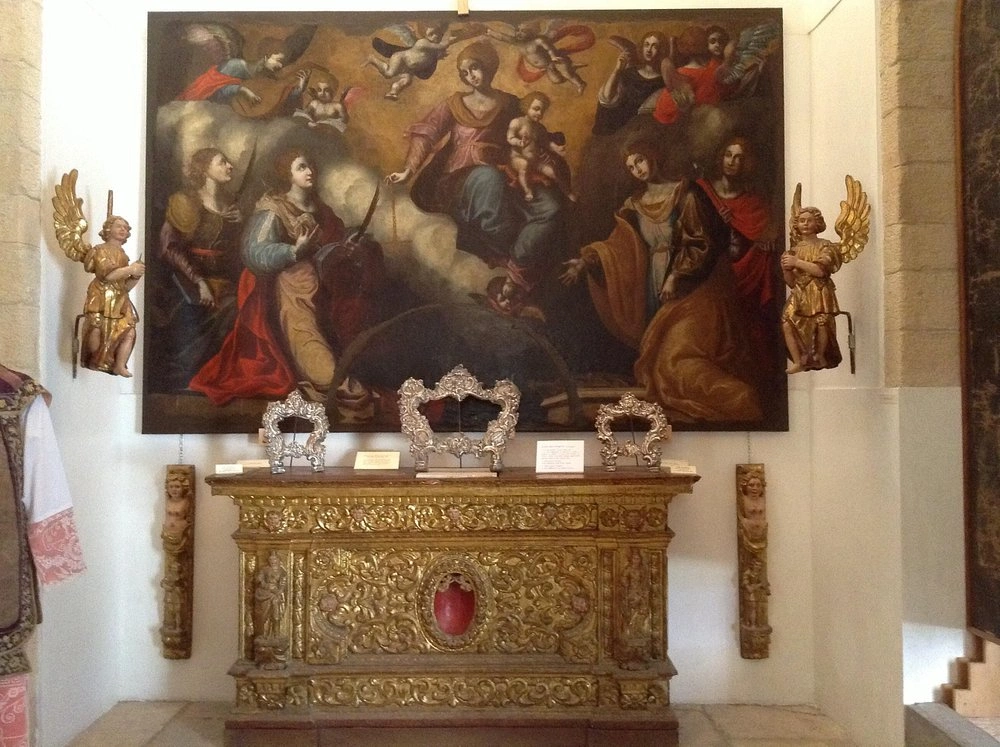
In 1981, the underground crypts of the old cemetery beneath the church were transformed into the Museum of Sacred Art of San Nicolò. This significant cultural institution preserves and displays a wide collection of religious artworks, liturgical objects, and historical furnishings from the mother church and its associated chapels. It provides insight into the rich religious heritage and artistic tradition of Militello in Val di Catania.
Feast Day
Feast Day : Saint Nicholas on December 6
Most Holy Savior on August 8 to August 25
The Mother Church of St. Nicholas and the Most Holy Savior in Militello in Val di Catania celebrates its two patronal feasts annually:
- Feast of the Most Holy Savior (Transfiguration) on August 6, with festivities from August 8 to August 25 .
- Feast of Saint Nicholas on December 6, known locally as San Nicolò Vetusto Patrono .
Both feasts are central to the town’s religious and cultural life, featuring processions, music, and communal gatherings that reflect the deep devotion of the local community.
Church Mass Timing
Monday to Friday : 7:00 PM
Saturday & Sunday : 7:30 PM
Church Opening Time:
Daily : Open 24 Hours
Contact Info
Address : Mother Church of St. Nicholas and the Most Holy Savior
Via Matrice, 7, 95043 Militello In Val di Catania CT, Italy
Phone : +39 095 883 8024
Accommodations
Connectivities
Airway
Mother Church of St. Nicholas and the Most Holy Savior, Militello in Val di Catania, Italy, to Vincenzo Bellini Catania Airport (CTA), distance between 49 min (44.2 km) via SS417.
Railway
Mother Church of St. Nicholas and the Most Holy Savior, Militello in Val di Catania, Italy, to Militello Railway Station, distance between 5 min (1.7 km) via Via Camillo Benso Conte di Cavour.

